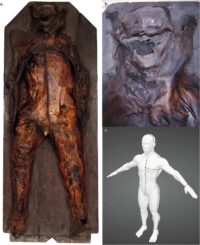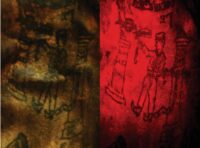Warning: this is a grisly one. The preserved heavily tattooed skin of a man held in a private collection in London has been studied for the first time, revealing tantalizing glimpses into his life.
Pieces of tattooed human skin were preserved as medical oddities in the 19th century, as anthropological specimens in the case of indigenous peoples of the Pacific, Asia and North America (tattooed Maori heads were sold as oddities), and as pathology specimens for Europeans thanks to the prevalent association of tattoos with criminality. The Wellcome Collection has about 300 examples, from flowers to dates to pinup girls, collected from “sailors, soldiers, murderers and criminals.”
 The subject of this most recent study isn’t a snippet of skin with a tattoo or two on it. This is the entire front of an adult male’s skin excised from ankles to top of the head, including face and ears. The genitalia were not preserved which made sex difficult to determine absolutely, although heavily tattooed women were exceedingly rare in the late 1800s so it’s reasonable to believe he was male on that basis alone. There is no evidence of breasts or facial hair. In the end it was the receded hairline typical of male pattern baldness that confirmed the likelihood of this having been a man.
The subject of this most recent study isn’t a snippet of skin with a tattoo or two on it. This is the entire front of an adult male’s skin excised from ankles to top of the head, including face and ears. The genitalia were not preserved which made sex difficult to determine absolutely, although heavily tattooed women were exceedingly rare in the late 1800s so it’s reasonable to believe he was male on that basis alone. There is no evidence of breasts or facial hair. In the end it was the receded hairline typical of male pattern baldness that confirmed the likelihood of this having been a man.
This is the only known example of a full-body incised tattooed skin in Europe. The only other examples are in Japan, where in the late 19th century after tattooing was outlawed men would get the funding to complete their body suits by agreeing to donate their flayed skin after death to the sponsoring collector or institute.
He was heavily tattooed with images and text on his limbs and torso, hence the extensive flaying and preservation. The word “BONHEUR,” French for happiness, was tattooed in capital letters above his genitalia. Researchers refer to him as Monsieur Bonheur as his name is not known.
Whoever removed the skin did an expert job, removing it just two sections using a pattern of incision that was once common in medical autopsies. CT scans confirmed that only the skin was removed, no other tissue. The edges  of the skin, including the “Bonheur” area above the pubis were then sewn back together with a post-mortem stitch to give it a unified appearance. The operation had to have been performed by someone with medical training and experience.
of the skin, including the “Bonheur” area above the pubis were then sewn back together with a post-mortem stitch to give it a unified appearance. The operation had to have been performed by someone with medical training and experience.
The skin was then mounted to a wooden board with flat-headed nails around the perimeter of the body and stuffed with horse hair to give a three-dimensional fullness. This work was rough compared to the surgical precision of the skin’s removal. It suggests the intent was display, not anatomical preparation.
When the remains of M. Bonheur were acquired by the present owner in Paris in the early 2000s, there was no documentation attesting to its age or the history of the person who it was attached to in life. The seller claimed it was the skin of a murdered hanged in Marseilles whose skin had been excised and nailed to the door of the court as a cautionary tale. This is not a plausible account, to put it mildly, and is typical of the tall tales associated with human skin curiosities like book bindings.
Because of postmortem discoloration and distortion of the skin, some of the tattoo groups were darkened and overlapping black outlines and black shading made them hard to discern. In the darkest areas, it was impossible to see if there were any tattoos at all. In order to penetrate the penumbra not just of the tattoos but of the treatment, the research team examined the skin using CT scanning, multispectral imaging, X-rays and infrared reflectography. The skin and hair were also analyzed using digital microscopy.
Researchers determined that there were between 55 and 60 pictorial tattoos and nine text elements. Image motifs include florals, animals, daggers piercing hearts, swords, flags and human figures (women and men). Human figures — full bodies, busts and faces — are the most common. The men feature a variety of facial hair and outfits, include clown hats and turbans. Some of the women have different hairstyles and what appear to be hats; some are nudes. One of the female images has the name Flourine tatted underneath it. That name appears in a second tattoo as well, so it’s likely M. Bonheur had a romantic relationship with her. An anchor and the text “Vive La Flotte” (“Long live the fleet”) indicate he was in the navy at some point.
 There is some indication that he might have had less than positive relations with law enforcement. An image of two crossed swords labelled “Mort aux Commissaires” (“Death to ‘Commissioners'”) is believed to refer to the Commissaire de Police Judiciaire, basically the police commissioner. Then there’s the more metaphoric approach: a tattoo of a uniformed man chained to a pillar with a bird delivering him “liberté” in his beak. The date 1883 is on the base of the pillar. Perhaps the date of his incarceration or release?
There is some indication that he might have had less than positive relations with law enforcement. An image of two crossed swords labelled “Mort aux Commissaires” (“Death to ‘Commissioners'”) is believed to refer to the Commissaire de Police Judiciaire, basically the police commissioner. Then there’s the more metaphoric approach: a tattoo of a uniformed man chained to a pillar with a bird delivering him “liberté” in his beak. The date 1883 is on the base of the pillar. Perhaps the date of his incarceration or release?
If the date on the pillar to which the tattooed figure in the (convicts?) uniform was chained, ‘1883’ did indeed refer to a date of release from prison or military servitude, then it would appear that for this individual that day never came. The portion of flayed skin then appears to have come into the possession of others who placed it on display. The practice of displaying tattoos would accord with an established nineteenth century tradition whereby heavily tattooed (living) individuals exhibited themselves for entertainment (Oettermann 2000). If this suggestion is true, it implies a European example of the ‘sideshow mummy’ phenomenon that was prevalent in the USA during the nineteenth and early twentieth century. Here unclaimed, embalmed bodies were exhibited for profit in circus sideshow and fairground attractions, commonly with a fictional or at least highly embellished story attached in order to increase their interest and profitability (Conlogue et al. 2008). In this respect, the story attached to M. Bonheur that was told to its current curator at the point the skin was purchased may in fact be of some antiquity and would also be consistent with this interpretation as ‘marketing’ for such an attraction.